
Thai art refers to a diverse range of art forms created in Thailand from prehistoric times to the present day, including architecture, sculpture, painting, textiles, decorative arts, crafts, ceramics, and more. While Buddhism has played a significant role in Thai art, with many sculptures and paintings depicting Buddha images and religious themes, nature, including flora and fauna, as well as mythical creatures, has been a major inspiration for Thai art, with colorful motifs appearing in various types of art forms. In contemporary Thai art, traditional works remain significant and continue to influence artists' concepts.

Wat Chedi Liam, formerly known as Wat Ku Kham, is one of the wats in the ancient Thai city of Wiang Kum Kam, now part of present-day Chiang Mai.

Wat Phra That Doi Chom Thong is located in Nakhon Chiang Rai, Amphoe Mueang, Chiang Rai Province, Thailand.

Wat Phra That Doi Suthep is a Theravada Buddhist temple (wat) in Chiang Mai Province, Thailand. The temple is often referred to as "Doi Suthep" although this is actually the name of the mountain where it is located. It is a sacred site to many Thai people. The temple is 15 kilometres (9.3 mi) from the city of Chiang Mai and situated at an elevation of 1,073 meters. From the temple, impressive views of downtown Chiang Mai can be seen.

The city of Nan's most famous wat is renowned for its cruciform ubosot which was constructed in 1596 and restored during the reign of Phra Chao Anantaworritthidet (1852-1892).

A wat is a type of Buddhist and Hindu temple in Cambodia, Laos, East Shan State, Yunnan, the Southern Province of Sri Lanka, and Thailand.
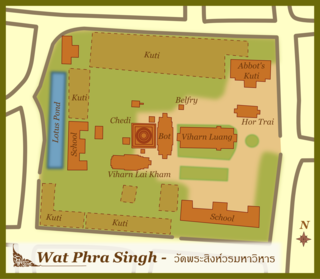
Wat Phra Singh is a Buddhist temple in Chiang Mai, northern Thailand. King Ananda Mahidol, bestowed upon it the status of Royal temple of the first grade in 1935.
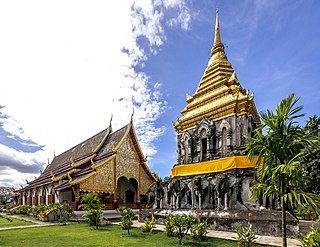
Wat Chiang Man is a Buddhist temple inside the old city of Chiang Mai, in northern Thailand.
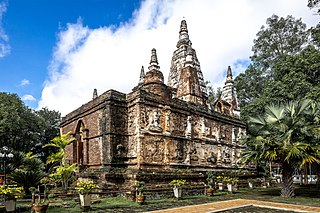
Wat Chet Yot or officially called Wat Photharam Maha Wihan is a Buddhist temple (Wat) in Chiang Mai in northern Thailand. It is a centre of pilgrimage for those born in the year of the Snake.
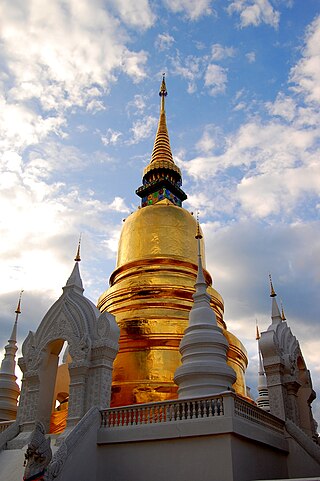
Wat Suan Dok, also known as Wat Buppharam is a Buddhist temple (Wat) in Chiang Mai, northern Thailand. It is a Royal Temple of the Third Class. The temple is on Suthep Road, approximately one kilometre west of Suan Dok gate at the west side of the moat.
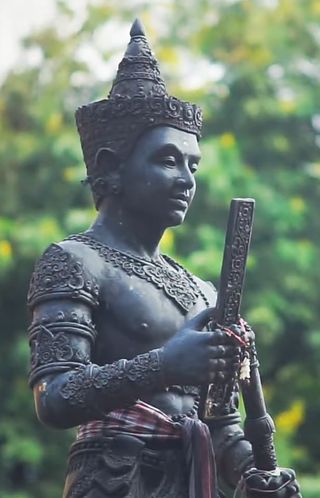
Tilokaraj, also spelt Tilokarat and Tilokkarat, was the 9th monarch of the Mangrai Dynasty.

Wat Ku Tao is a Buddhist temple in Chiang Mai, Thailand. The temple was built in 1613 to enshrine the remains of Nawrahta Minsaw, the first Burmese ruler of Lan Na. The temple is known for its distinctive chedi, which was built in the Yunnanese style, arranged in a series of five diminishing spheres that represent the five historical and future Buddhas. The temple presently caters to Chiang Mai's Shan community.

Wat Chiang Yuen is a Buddhist temple in Chiang Mai, Thailand, located north of the Old City, about 600 metres (2,000 ft) east of Wat Lok Moli. First built in 1500s, Lanna kings historically paid homage to the Phra Suppunyu Chao Buddha image at the temple before their coronation. The temple was abandoned during Burmese rule, and was reconstructed in 1794 by King Kawila. The temple is known for its large chedi, which has a whitewashed square base guarded by Burmese chinthe on each corner, an octagonal middle section dotted with porcelain flowers, and a five-tiered hti crowning the stupa. The Lanna-style sala is buttressed by two elaborately decorated poles called tagundaing, each topped by a hamsa.

Chiang Saen is an old city in Northern Thailand. Chiang Saen is the capital of the Chiang Saen district, which lies in the north of the Chiang Rai province.

Wat Mahawan is a Buddhist temple in Chiang Mai, Thailand. It is located on the eastern periphery of the old city of Chiang Mai in Thaphae Road.

Wat Phan Tao is a Buddhist temple in Chiang Mai, northern Thailand. It is situated on Prapokklao Road, Mueang Chiang Mai district, in the centre of the old city.

Wat Phuak Hong is a Buddhist temple in Chiang Mai, northern Thailand. It is situated on Samlarn Road in the old city.

Wat Umong Maha Thera Chan is a Buddhist temple in Chiang Mai, northern Thailand. It is situated on Ratchapakhinai Road in the centre of the old city.

Wat Rampoeng, also known as Wat Taoptharam, is a Buddhist temple in Chiang Mai, northern Thailand. It is situated in the area of Suthep subdistrict, Mueang Chiang Mai, on the outskirts of the city. The temple is well known for its meditation centre.

Wat Mo Kham Tuang is a Buddhist temple in Chiang Mai, northern Thailand. It is situated in the old city overlooking the north side of the moat which surrounds the city.





















